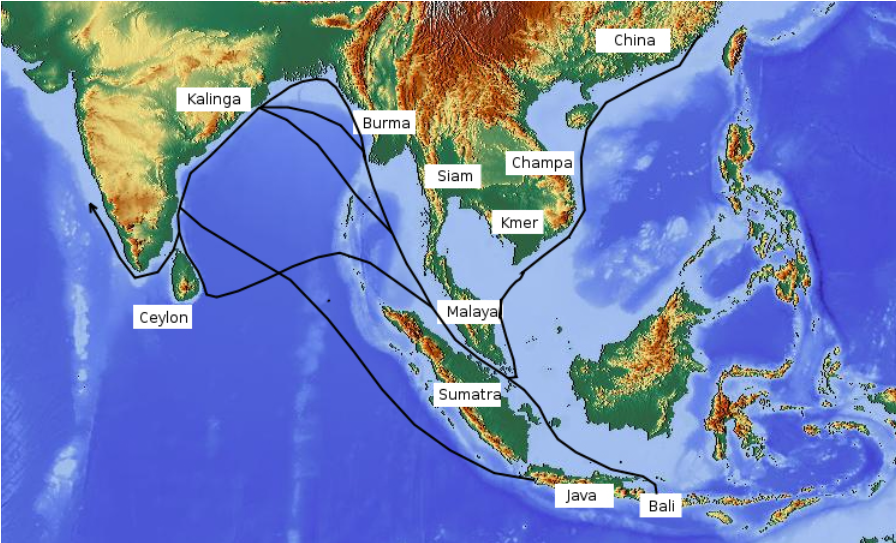Baliyatra | 18 Nov 2022
For Prelims: Baliyatra, Mahanadi, Bay of Bengal, Kalidasa
For Mains: Kalinga empire’s links with Southeast Asia
Why in News?
Recently, the Prime Minister in his address to the Indian diaspora in Bali on the sidelines of the G20 summit mentioned the annual Baliyatra on the banks of the Mahanadi in Cuttack that commemorates age-old links between ancient Kalinga and Southeast Asia.
- Baliyatra of year 2022 also found a place in the Guinness World Records for achieving an impressive feat of origami, the creation of beautiful paper sculptures.
What is Baliyatra?
- About:
- Baliyatra, literally ‘voyage to Bali’ is one of the country’s largest open-air fares.
- Baliyatra is a week-long event which begins on Kartik Purnima (full moon night in the month of Kartik)
- Historical/Cultural Significance:
- It is organised every year to commemorate the 2,000-year-old maritime and cultural links between ancient Kalinga (today’s Odisha) and Bali and other South and Southeast Asian regions like Java, Sumatra, Borneo, Burma (Myanmar) and Ceylon (Sri Lanka).
- According to historians, popular items of trade between Kalinga and Southeast Asia included pepper, cinnamon, cardamom, silk, camphor, gold, and jewellery.
- The Bali Yatra celebrates the ingenuity and skill of those expert sailors who made Kalinga one of the most prosperous empires of its time.
- Commercial Significance:
- Baliyatra has a significant commercial dimension in addition to its cultural and historical elements.
- It is a time when people purchase everything from automobiles and electronic devices to local artisanal products at prices that are comparatively low.
- The district administration allots more than 1,500 stalls to traders through an auction, and the fair is estimated to see business worth more than Rs 100 crore over the period it lasts.
- Baliyatra has a significant commercial dimension in addition to its cultural and historical elements.
How is Kalinga linked with Southeast Asia?
- Origin – Growth of Ports: The Kalinga Empire (present-day Odisha) is known for its glorious maritime history. Due to the geographical location of Kalinga, this area saw the growth of ports as early as the 4th and the 5th century BC.
- Some of the famous ports, Tamralipti, Manikpatna, Chelitalo, Palur and Pithunda allowed India to connect with other countries via the sea. Soon, the Kalingas had trade links with Srilanka, Java, Borneo, Sumatra, Bali and Burma.
- Bali formed a part of the four islands that were collectively called the Suvarnadvipa, today known as Indonesia.
- Some of the famous ports, Tamralipti, Manikpatna, Chelitalo, Palur and Pithunda allowed India to connect with other countries via the sea. Soon, the Kalingas had trade links with Srilanka, Java, Borneo, Sumatra, Bali and Burma.
- Kalinga's Ships: The Kalingas constructed large boats called the ‘Boitas’ and with the help of these, they traded with the Indonesian islands.
- The Bay of Bengal was once known as the Kalinga Sea as it was thronged by these ships.
- The dominance of the Kalingas over the sea routes can be understood from the fact that Kalidasa in his Raghuvamsa referred to the King of Kalinga as ‘The Lord of the Sea’.
- Cultural Exchange with Indonesia: The Kalingas frequently traded with the island of Bali. The trade-in commodities also led to the interchange of ideas and beliefs.
- Odia merchants formed settlements in Bali and influenced its culture and ethics which led to the growth of Hinduism in the region.
- Hinduism blended well with the Balinese concepts and even today, ‘Balinese Hinduism’ is practised by a majority of their population.
- They worship various Hindu Gods such as Shiva, Vishnu, Ganesha and Brahma.
- Shiva was considered to be the presiding deity and believed to be the elder brother of Buddha.
- Hinduism blended well with the Balinese concepts and even today, ‘Balinese Hinduism’ is practised by a majority of their population.
- The Balinese also celebrate Hindu Festivals such as Shivaratri, Durga Pooja and Saraswati Pooja.
- The ‘Masakapan ke Tukad’ festival celebrated in Bali is similar to the Bali Yatra festival in Odisha. Both are celebrated in the memory of their maritime ancestors.
- Odia merchants formed settlements in Bali and influenced its culture and ethics which led to the growth of Hinduism in the region.

